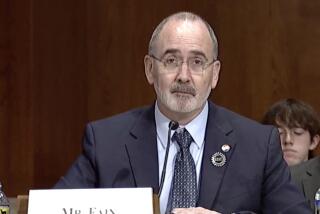AQMD Plan Tries to Clear the Air : 4-Day Work Week Introduced to Cut Pollution by Commuting Employees
EL MONTE â The Southcoast Air Quality Management District has launched a 4-day work week for its employees in an effort to cut air pollution by reducing the number of cars on the road.
Under the 5-week-old program, known as â4/10,â employees work four 10-hour days and take off one weekday, said district spokesman Bill Kelly. On any given day, about 20% of the districtâs 850 employees do not have to commute to work, he said.
15% Reduction
âWe estimated that it will reduce 190 tons of pollutants a year from cars driven to and from the district,â Kelly said. âThatâs a 15% reduction.â
The 18-month pilot program is part of the districtâs overall ride-reduction program that includes van and car pools, public transportation subsidies and cash incentives for people who share rides, bicycle or walk to work.
The district, which regulates air-quality standards in Los Angeles, Orange and Riverside counties and the non-desert portion of San Bernardino County, established a 4-day work week to meet vehicle ridership targets that the district set for itself and about 8,500 other employers in Southern California.
Under Regulation 15 adopted by the district last year, employers with more than 100 workers must submit plans designed to increase âaverage vehicle ridershipâ to 1.5 riders per car in suburban areas and 1.75 in more congested urban areas, Kelly said.
With 3.5 million commuters in the districtâs 4-county area jamming the freeways during rush hours, average car ridership is 1.13.
Under district policy, employers can earn credits toward meeting their ridership targets if they provide such programs as ride sharing, bus-fare subsidies and compacted work weeks.
With the 4/10 program, for example, the district earns enough credits to boost its 1.34 average ridership to 1.6 persons per car, said Chris Nelson, transportation management coordinator for the district.
Although that figure exceeds the 1.5 ridership target the district must meet under its own regulation, the district has voluntarily raised its own target to 2.0.
âItâs important that the district be a model for other companies and agencies,â said Jacqueline Switzer, a district spokeswoman. âWeâve got to be the ones to lead the way.â
About six years ago, the district experimented with a 4-day work week for two departments but discontinued it partly because officials preferred that all departments be on the same schedule.
To log 40 hours in a 4-day week, district employees still start work at 7 or 7:30 a.m. but work 10 instead of eight hours. Employees who take 30-minute rather than 1-hour lunches may leave a half-hour early.
District offices remain open to the public from 8 a.m. to 5 p.m. each weekday.
Employees interviewed say they like the new work schedule.
âIâm more tired than I was on the other schedule, but I love having the day off in the week,â said Paula Levy, who works in the districtâs public advisers office. She has adjusted to the longer hours by spending late afternoon hours working on routine matters that require less concentration.
Bill Wong, a deputy district counsel in the districtâs legal department, also enjoys having a day off during the week. He went shopping on a recent Thursday and avoided weekend crowds.
âWhat the district likes is you donât pollute the air as much,â said Wong, who drove only 5 miles for his shopping trip instead of driving 50 miles to and from work. Fewer morning commuters also means less ozone pollution, which is created by a chemical reaction that takes place in sunlight, Kelly said.
Welcome Return
Engineer Fred Lettice, who worked a 4-day week when the district offered the option to the engineering department six years ago, said he is glad the program is back.
âI enjoy it a great deal,â Lettice said. He said his union, the Federation of Public Sector Workers, also supports the 4-day work week.
One recent Monday on his day off, Lettice slept for an extra hour, did some chores and picked his sons up from a day care center.
Lettice said he enjoys the quiet hours at the end of his work day when the district is closed to the public.
âThat gives me the last hour of the day to get things cleaned off and get ready for the next day,â he said.
A shorter work week, however, has complicated communications within and between departments.
âItâs hard to find one day when everybody is available for a meeting,â Lettice said.
But employees are finding ways around the problem. For example, staff members in the legal division have selected Wednesday as a core day when everyone has to be at work.
Employees request the day of the week they prefer not to work. Those with seniority and those who share rides, walk or bicycle to work have a better chance of getting their first choice.
Letticeâs 5-person car pool had no trouble getting the groupâs first choice--Mondays--off. But Wong, who joined the legal department just eight months ago and who drives to work alone, had to settle for Thursdays off instead of Fridays.
Some employees may not be able to get the day they want off because of work requirements. A payroll department employee, for example, may be required to work on designated days so the district can meet payroll deadlines.
If an employee has to continue with a 5-day work week because of child-care or after-work class schedules, he or she can apply for a hardship exemption. But inconvenience alone is not a valid reason. The exemption only lasts for a limited period since employees are expected to resolve their hardships. So far, 50 of the districtâs 850 employees have been granted hardship exemptions, Kelly said.
The district, in hopes that 4-day work weeks and other ride reduction programs will catch on with other employers, emphasizes the programâs economic benefits.
By reducing the number of employees who must report for work each day, Kelly said, employers could reduce the number of parking spaces needed. Fewer cars on the freeways also mean fewer traffic jams and less employee tardiness, he said.
The district is notifying 200 employers a month that they have to adopt a plan to meet the ridership goal for employees.
In July, the district began notifying employers with 500 or more employees--about 1,200 firms--of the requirements. After notification, an employer must submit a trip-reduction plan within 90 days. AQMD has 60 days to approve or reject the plan.
Next year, the district will notify 2,800 employers with 200 to 499 employees, and in 1990, it will notify 4,500 employers that have between 100 and 199 employees.
About half of the 300 plans that were due Dec. 8 have been submitted, Kelly said. Employers who submitted plans indicated that they plan to offer programs ranging from flexible hours to car-pool subsidies, Kelly said.
A few also came up with more creative suggestions. For example, a hospital in Orange County said its cafeteria has established a âcar-poolâ line offering express meal service for employees who share rides to work.
The district will evaluate its â4/10â program in six months, but early employee feedback indicates that the shorter work week is popular.
Lettice, who told friends about the districtâs compacted work week, said, âThey appear rather envious of our having a 4-day work week.â
More to Read
Sign up for Essential California
The most important California stories and recommendations in your inbox every morning.
You may occasionally receive promotional content from the Los Angeles Times.










